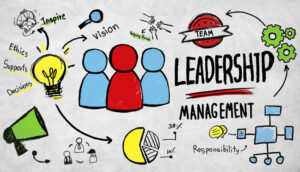Paul Pember shares 9 traits that makes team leaders high performing, with practical tips for how you can put these traits into practice from today.

Paul Pember
Are you unclear on how to define what a high-performance team leader is?
Do you want to go from good to great?
Do you want some practical tips to move into high performance?
If so, then read on…
The 9 traits are:
1. They’ve Developed a Critical Leadership Behaviour: Accountability
Recognize when you’re being negative and showing unaccountable behaviours.
Working in customer services isn’t for the faint hearted, right? It can be fast paced, and the effective running of customer service team can be reliant on many dependencies seemingly out of our control.
I’m going to challenge this assumption!
You can control and influence everything. High-performing team leaders have the ability not to get stuck in the ‘moaning mud’, by not wasting energy and time being negative and waiting for things to sort themselves out. Instead, they take ownership, find solutions, and make things happen.
This behaviour is often the secret ingredient for team leaders wanting to get promoted to more senior positions.
Practical Tips:
- Recognize when you’re being negative and showing unaccountable behaviours.
- When you’re faced with a challenging situation, take a moment to think about all the possible things (however small) you can do to change the situation. Take time to reflect. There could be other more positive ways to tackle something.
- Research and use the incredibly useful ‘accountability ladder’, this tool will support you in moving yourself up the ladder to more accountable behaviours.
2. They Develop Trusting Stakeholder Relationships
High-performing team leaders focus on building open and trusting two-way relationships with their key stakeholders across the organization. This is achieved through both formal and informal regular conversations, with a focus on working together to improve the customer experience.
Practical Tips:
- Build your own stakeholder map and identify two key relationships to focus on.
- Don’t just contact your stakeholders when you need something or when something goes wrong.
- Schedule regular ‘check-in’ sessions to help develop the relationship.
- Be clear on what you value from that stakeholder, and what you’d like to work with them on.
- Equally, it’s an opportunity to gain feedback about your team from their perspective.
To find out more about improving communication within the contact centre, read our article: How to Improve Internal Communication in the Contact Centre
3. They Focus on ‘Pulling’, Not ‘Pushing’
This is about focusing your energy on activities that motivate and engage your team that ‘pull’ them towards you.
This can include building deeper relationships with your team members by focusing on their personal development and getting to know them: What are their hobbies? What’s going on for them outside of work?
This is much more effective in increasing engagement and productivity than simply focusing on their operational metrics.
Practical Tips:
- Review your calendar and identify which activities and how much time you’re currently investing in team engagement.
- Understand the key drivers of dis-engagement within your team, and work through them with the team – empowering them to take ownership of the initiatives.
- Examples of ‘pulling’ activities:
- ensure your team have a voice and can get involved in improvement projects and other organization-wide initiatives,
- remove barriers that prevent the team from serving the customer,
- give each of your team members something to lead on in addition to their core role (e.g. subject matter expert on a specific service/product, social lead or process improvement lead),
- focus on personal development and developing career pathways.

It is important to motivate and engage your team to ‘pull’ them towards you
4. They Are Proactive and Pre-empt Future Issues
I’m sure we can all think about that unexpected busy day the contact centre has faced. A high-performance team leader isn’t just about being great at reacting quickly and effectively to these challenging days and ensuring the impact on the customer is limited through real-time mitigations.
They are one step ahead because they anticipate future issues and put mitigation plans in place to prevent them from occurring in the first place.
A few examples of how this can be achieved are: having strong stakeholder relationships which will enable you to influence outbound communications that may have a negative impact on contact demand or being part of the sign-off process before communications are published, enabling a ‘customer’ voice to be part of the final communications.
Practical Tips:
- Schedule time in your diary &/or in management meetings to think about and discuss potential obstacles in the short and long term that the customer services team may face.
- Log and track these issues with mitigations that can be implemented to limit the impact. Record lessons learnt when issues arise so they can be handled effectively next time.
- Contact centres are data rich – use this data to identify trends that can help plan resourcing and workload/
5. They Have Strong ‘Coaching’ Capability
They have the ability and confidence to create time for coaching conversations, supporting team members, and increasing agent capability.
Develop your coaching muscles – read, listen, and practise.
Pitched in the right way, this will help you create followers and dedicated agents who feel you invest time supporting them to become better.
They create a culture within their teams where coaching happens in both formal and informal situations and encourage agents to coach each other depending on the learning need.
Practical Tips:
- Develop your coaching muscles – read, listen, and practise. One easy way to practise this if you’re a beginner is to focus your first coaching conversation on the great things an agent does. This will support you in feeling more confident and comfortable having this style of conversation.
- Think about what a great coaching conversation might look like.
- Focus on creating a coaching culture, with the team knowing this is to enable them to reach their full potential.
- Match two agents together who can both learn from each other and start peer-to-peer coaching.
- Set expectations on the behaviours you would like to see during coaching conversations – ownership, accountability and listening.
To read more about how to conduct effective coaching sessions, read our article: 10 Great Ideas for Successful Call Centre Coaching Sessions.
6. They Have a Service and Organization Mindset
High-performance team leaders don’t just look after their individual team but proactively contribute to the wider department by supporting and collaborating with other teams. They are aware of what’s happening across the department and actively involved in organization-wide initiatives.
This supports them in boosting their personal profile and the contact centre and supports them to have a wider understanding on how the organization operates.
Practical Tips:
- Invest time in keeping in touch with what’s happening across the organization: reading newsletters, intranet articles and being active in organizational initiatives.
- Reach out to your fellow team leaders and see if you can support them with issues they are currently facing.
7. They Are Evidence and Insight Driven
Understand your customer insight.
High-performance team leaders have a clear and deep understanding of data and insight. They can confidently discuss themes, trends in performance, demand, and customer insight. They can turn data into actionable insight for their service and the wider organization.
This insight allows for more productive evidence-based stakeholder conversations, which enables you to focus on what matters rather than the most recent issue, which may be low impact on the customer.
Practical Tips:
- Understand your customer insight – why are customers contacting you? What periods in the day/week/month have the highest demand? What is driving disatisfaction?
- Understand your team insight – what are the key development/training gaps in your team?
- If you had one minute with the CEO to discuss key insights about your team, what would you say?
To find out more about call centre metrics, read our article: What Are the Industry Standards for Call Centre Metrics?
8. They Don’t Shy Away From Underperformance or Behavioural Issues
This is without doubt one of the more difficult activities any manager must do. High performance is tackling this early on – whether it’s capability or disciplinary, they ensure poor behaviour doesn’t spread across the team and clearly role model a minimum standard.
Be clear with your team about your performance expectations and ‘bring your team with you’ by developing a clear picture of what underperformance looks like in practice.
High-performing team leaders clearly demonstrate and communicate to the team what underperformance looks like and how agents make progress towards performing and high performance.
Not tackling performance and behavioural issues can be one of the key reasons for low team engagement, as other performing team members start to feel demotivated that someone is ‘getting away’ with it. This can undermine your ability to gain respect from your team.
Practical Tips:
- Be courageous and take the step in having that difficult performance conversation. If you’re new to this, find a mentor who can support you in developing your confidence with having these types of conversations.
- Be clear with your team about your performance expectations and ‘bring your team with you’ by developing a clear picture of what underperformance looks like in practice. This can be co-created with your team to enhance engagement and buy-in.
- Reward team members who role model the right behaviours to encourage and inspire others.
For ideas on how to provide feedback to staff, read our article: 10 Good Feedback Examples to Improve Contact Centre Performance
9. They Wear a Customer Experience Hat
High-performance team leaders think and consider the customer experience. They achieve this by always seeking ways to improve the end-to-end journey, rather than just handling a conversation well or hitting your team operational targets.
They regularly identify improvements to the customer journey, and actively take ownership on driving the improvement through to completion.
They don’t just see a contact as a transaction but think more widely around the reason the customer contacted and how that experience could be improved.
Practical Tips:
- Gain an understanding of how the customer experience could be improved – are people contacting due to a confusing online journey? Did they receive a communication that wasn’t clear?
- Test out the experience yourself – walk in the customer’s shoes and be a ‘customer’ of your organization.
To read more about how you can improve the customer experience, read our article: Improve Customer Experience: 5 Strategies That You NEED to Try
Time for some reflection:
How many of these traits do you show every day?
Which one are you going to focus on this month?
Which practical tips are you going to use?
Thanks to Paul Pember for sharing this article with us.
For ideas on how to develop your team leaders, read our articles:
- Team Leadership: What Makes a Great Leader?
- 7 Pillars for Creating Amazing Team Leaders
- Top Tips to Make Your Team Leaders More Productive
Author: Paul Pember
Reviewed by: Robyn Coppell
Published On: 30th Jun 2021 - Last modified: 5th Sep 2024
Read more about - Call Centre Management, Coaching, Editor's Picks, Leadership, Paul Pember, Performance Management, Team Management






































